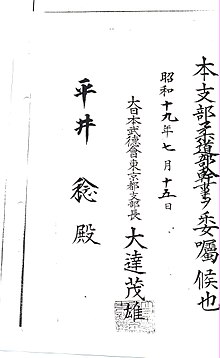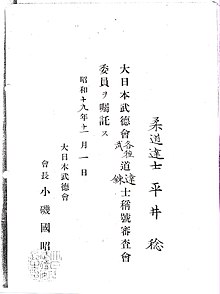Hirai Minoru
Hirai Minoru ( Japanese 平井 稔 ; * 1903 ; † 1998 ) is the founder of Kōrindō-Aikidō . As a member of the then central martial arts association of Japan , the Dainippon Butokukai (DNBK), he was appointed to reunite the Budo martial arts , which had been split up into different schools , into an overall system. In this function he became on September 5, 1946 the first and only owner of the title awarded by the DNBK " hanshi " of Aikido . Before that he was the manager of Ueshiba Morihei's dojo and training director. He also had his own Dōjō Kōkadō in Okayama .
From 1947 Hirai used the name "Kōrindō" ( 光 輪 洞 ) for his dōjō, next to it "Kōrinkai" ( 光 輪 会 ) as the organizational name for the association. “Kō” ( 光 ) stands for light or rays of light, “rin” ( 輪 ) for wheel or ring and “dō” ( 洞 ) for grotto, in a modest allusion to dōjō. Kōrindō can therefore be understood as a light-filled grotto or a grotto that shines with light. In Buddhist iconography, however, "Kōrin" also stands for wreaths of lights on the heads of saints and as a symbol refers to being enlightened, the satori.
The term "Aiki" has long been known in various associations, such as Aiki-Budō or Daitō-ryū Aiki-jūjutsu , but aikidō was first established as a new term after long deliberations within the Dainippon Butokukai and based on the Budō system, such as it represented Minoru Hirai, applied. The proposal for the name Aikidō was brought in by Hirai himself and by prominent colleagues in the Dainippon Butokukai, such as Tatsuo Hisatomi (board member and president of the Jūdo Association " Kōdōkan ", head of the secret service staff in the Prime Minister's Office) and Shōhei Fujinuma (head of the Kōdōkan section and also member of the board of the Butokukan, chief of police chief of Osaka ).
When the decision was made to choose a name for his Budo system, Hirai would have favored the name Jūdō , because the syllable jū in Jūdō is nothing more than the Sino-Japanese reading of the term “ yawara ” (suppleness, flexibility), which in Hirai's concept of Budo plays a central role. However, this name was already occupied by Kanō Jigorō , who had developed his Jūdō from traditional Jiu Jitsu .
As an alternative to Jūdō, Hirai tried, among other things, the designation "Sōgo-Budō" (total Budō) to suggest, but this was rejected by the competing sections as too presumptuous. Ultimately, it was decided to use the term Aikidō, which was subsequently also used by Ueshiba Morihei.
Ueshiba and Hirai first met in 1939 in Okayama, a prefecture in western Japan. After several other meetings, Ueshiba invited Hirai to Tokyo in 1939 so that he could teach in his dojo. In January 1942, when Ueshiba retired to Iwama , he transferred the overall management of his dojo to Hirai, while Ueshiba's son Kisshomaru , then still a student of economics, took over the function of director at the same time. Hirai left the Kōbukan after a relatively short time , as he did not consider his style to be compatible with the Ueshibas.
During his work in Ueshiba's Dōjō, relationships based on trust had developed between Hirai and other important personalities, such as Tomita Kenji , (chairman of the board of the "Kōbukan" and later State Secretary of the multiple prime minister, Prince Konoe Fumimaro ), and Kisaburo Ōsawa, to whom Hirai finally took the lead Ueshiba's Dōjō "Kōbukan" resigned. Both Ōsawa and Tomita tried to win Hirai back for Ueshiba's Dōjō after the end of the war, but without success, since Hirai was firmly convinced of the correctness of his system. Kisaburo Ōsawa in turn retained the function of director in Ueshiba's Dōjō until 1986, when Ueshiba's grandson Moriteru became head of the Aikikai .
Hirai was - in contrast to numerous other statements - according to information from his son Tomohiro, neither sent by Ueshiba to the Butokukai nor appointed as a representative of the Kōbukan, but was asked to cooperate regardless of his special abilities.
Hirai's Budo system is, in the opinion of Hirai's son Tomihiro, strongly influenced by the Nitōryū of the Okumura School, which was located across from Okayama Castle. Hirai enjoyed from childhood, thanks to his grandfather, as well as his uncle, lessons in various martial arts, including in particular in Tōgunryū, so that it was often assumed that this school would have been formative for Hirai. Tōgunryū is considered to be the style in which the 47 samurai ( 47 rōnin ) of the Chushingura vendetta story were trained. However, according to Tomohiro, this is not the case. Rather, it was the famous sword school of the Okumura-Nitōryū that Hirai devoted himself most intensively to, starting in 1918, when he was about fifteen. It was this that gave the decisive impetus for the development of Hirai's unique “ taisabaki ” method. Hirai had a lifelong friendship with Torakichi, the son of the head of the Okumura school, Okumura Sagenta. Torakichi was later to become a teacher at the Dainippon Butokukai as well.
In addition to the art of swords, Hirai also increasingly dealt with the Jūjutsu, including especially the styles Kitōryū and Takeuchiryu-Jūjutsu. The latter brought him into contact with the concept of "koshi-mawashi", which he, together with " yawara ", regarded as essential foundations of his budo system.
Key terms in Hirai's system include enwa-ichigen (circular, harmonious movements as the origin of all things, with en as a circle, wa for harmony and ichigen for the sole origin, single root). This type of movement is practiced with his special method, the specially developed taisabaki , deepened with kata exercises and internalized in the exercise forms enrandori and randori .
A detailed treatment of the basic terms used by Hirai, as well as concrete exercise instructions on the basis of his philosophical principles can be found in the book “Kōrindō-Aikidō. The Hirai Minoru Budô System ”. This book contains the video recordings transcribed by his student Shinjūrō Narita (9th Dan and Sōshihan) of a series of lessons that Hirai held for a select group of students over two years, from 1981 to 1983. The work is therefore to be seen as an authentic legacy of Hirai's teaching.
swell
- "Interview with Minoru Hirai", in: Aikido Journal 1994, Vol. 21, No. 3, pp. 10-15
- Mochizuki, Minoru, "Michi" to "tatakai" wo wasureta nihon budō ni katsu! , Tokyo 1995
- Narita Shinjuro, Kōrindō-Aikidō. The Budō system of Hirai Minoru , translated and edited by Gerhard Hackner, Norderstedt 2007. ISBN 3-8334-9086-1
Web links
| personal data | |
|---|---|
| SURNAME | Hirai, Minoru |
| ALTERNATIVE NAMES | 平井 稔 (Japanese) |
| BRIEF DESCRIPTION | Japanese martial arts athlete, founder of Kōrindō-Aikidō |
| DATE OF BIRTH | 1903 |
| DATE OF DEATH | 1998 |


